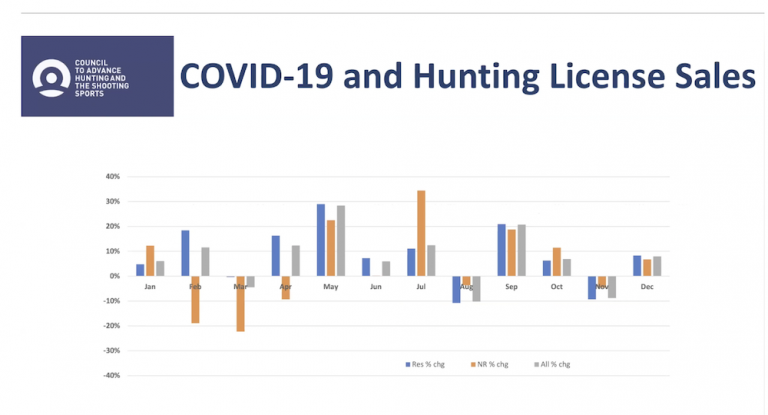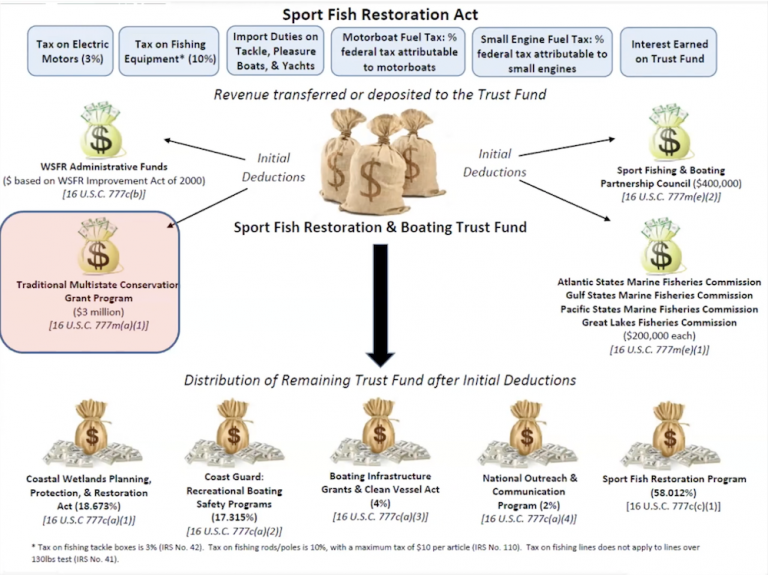Though the stats are impressive, Baer noted that only two out of three people who take a hunter education course actually go on to buy a license. So how do we fix that? Baer offered a few possibilities, like offering virtual, in-person, and hybrid courses to provide attendees with options. He also suggested that the industry should offer courses tailored to different skill levels to allow for further customization. For example, an attendee with prior hunting experience isn’t going to need or want as detailed of a course as someone without any experience. Providing shorter “refresher” courses along with full, in-depth courses could make the process of attaining a hunting license more achievable. They are conducting surveys to learn how potential hunters want to receive their education and what they’re looking for in the courses. The shortened courses would, of course, still focus on safety as the No. 1 priority and not compromise anything in that area. Baer also noted that state agencies need to think about the influx of women and people of different backgrounds participating.
Another suggestion was offering a list of specific places where people can go to hunt upon completion of the course to make it easier to connect and follow through. Retailers and ranges can also offer their own programs to those who have completed the course and are looking for more resources and education. Even if a new participant does not feel comfortable hunting on their own yet, they may be interested in additional education opportunities from a local instructor.
Look to Today’s Adventure as an example. Today’s Adventure, produced by Kalkomey, launched in the second quarter of 2020. It’s an interactive e-learning program that’s personalized and self-paced. Greg Gulliver, vice president of agency relations at Kalkomey, noted that they’re trying to balance the time regulations and the need for the courses to be long enough to be safe and convey the necessary information while being short enough to not be overwhelming. Students, for example, can’t afford to spend a lot of time on the courses. Their program saw a 133% increase across all hunter education programs offered by Kalkomey when comparing 2019 and 2020 statistics. And 60% of students who completed a hunter education course indicated an interest for continued education. Gulliver also agreed with Baer that providing options is the way to go and noted that there are still hunter education participants out there who want a traditional, in-person learning experience, even if an online version is offered.
Mark Norquist, founder of Modern Carnivore, also suggested Hunting Camp Live in the forum comments, noting that it’s an introduction to the culture and community of hunting rather than certification and compliance.
https://youtu.be/s2qVAIoTriA
Marketing to New Demographics
Archery, bowhunting and the great outdoors are for anyone and everyone. The statistics support the fact that more women and people of color participated in outdoor recreational sports in 2020 than in 2019. So, let’s strive to retain the participation and show diverse audiences that they are welcomed and encouraged in the outdoor industry. Jimmy Flatt, founder of Hunters of Color, shared a statistic from a 2016 USFWS study that showed that 97% of all hunters are white. “It’s not that people of color don’t want to hunt,” Flatt said during the presentation. “We all have an interest in hunting and we all share the same connections to our ancestral roots that are derived from hunting. What we want to see as an organization is this graph shift to be more representative of what the United States graph would look like.” He then shared the statistic that by 2045, non-Hispanic, white Americans will no longer make up the majority of the U.S. population. Flatt said that we need to do active and real outreach to the Black, Indigenous and people of color (or BIPOC) communities. Let them know that they’re welcome and encouraged.
Hunters of Color, launched in August 2020, is already actively encouraging landowners to open their land for turkey hunting in Oregon and has held successful turkey hunts. The group is also partnering with the National Deer Association and other organizations for Field to Fork programs in New York and school curriculum programs in New Mexico and Montana to include a curriculum for hunting ethics, safety, butchering and cooking. For individuals looking for a mentor, the group offers a mentorship program as well, with 83 total active mentors and mentees. Hunters of Color encourages anyone in the outdoor industry to partner with them.
Ashley Chance, Southeast coordinator for Artemis Sportswomen, presented information about the organization, which seeks to build a community to retain sportswomen and change the face of conservation. Chance noted that women aren’t represented as visibly in leadership roles in the industry. Referencing a study by McFarlane, Watson & Boxall from 2003 in her slides, Chance also noted that women “exert a disproportionate influence” over their children’s hunting behavior. So, if you are able to recruit more female hunters, you will, in turn, recruit more hunters in general because they will encourage their children to participate. However, she also noted that women stop participating in hunting more often than men. To help combat that decline, Artemis has created a community. They host women-led hunts annually along with conservation-based work parties and check-in calls with their ambassadors. They also host a book club, a podcast, advocacy events, and informative webinars. They’ve launched a Go Confident Course to help provide better training for sportswomen, like backcountry skills and bear safety. When she moved to the Southeast, Chance noticed that constraints there are unique and different than in the West. Chase and Artemis are trying to implement a survey for female license holders to learn what’s holding them back, so they can focus their efforts. She’s actively looking to partner with state wildlife agencies in the Southeast to distribute the survey to past license holders. Chance also encouraged organizations to have members of Artemis on their panels to speak about conservation issues. Graduates of the Becoming an Outdoorswoman program are encouraged to become Artemis ambassadors.
Encourage and Promote Diversity and Inclusion: Work with Inclusive Organizations
Reach out to organizations locally or nationally, like Artemis or Hunters of Color, and discuss the possibility of a collaboration or partnership. Sharing their content and stories on your website or social media will provide your audience and customers with diverse stories that reflect the diversity of the country. If we can increase representation for archers and bowhunters of different races, genders, ethnicities, orientations, abilities and backgrounds, we can demonstrate to those underrepresented groups that they are welcome, encouraged and valued in this industry.
The ATA created a Diversity, Equity and Inclusion Committee in October 2020 to identify and develop strategies to make the industry more inclusive and equitable for people of any race, gender, ability and background. The committee includes two ATA staff members and six representatives from the archery and bowhunting community. Samantha Seaton, ATA’s Academy and Community program manager and one of the founders of the DEI committee, has worked closely with Artemis and participated in one of its podcast episodes. You can listen to that podcast here. Chance was also a guest on the ATA’s Engaging Women Hunters webinar, available to ATA members on the MyATA Learning Center here. Seaton and Kurt Smith, ATA’s director of industry relations, also hosted DEI committee members Mike Jasper and Immanuel Salas on a recent episode of the ATA’s Beyond the Bow podcast. Jasper and Salas discussed the ups and downs of their experiences getting into the archery and bowhunting industries, what they enjoyed about their positive experiences, and what retailers and other industry professionals can learn from their negative experiences. You can find the Beyond the Bow podcast and the different avenues for streaming here.
https://youtu.be/JDUVuPLMuwU
How Do We Bring in the College-Aged Audience?
College-aged hunters are also a market that industry professionals should consider recruiting as they’ll be likely to recruit their friends. Habits formed in college are often lifelong. While the interest may be sparked during college, if it’s difficult for them to follow through, buy a hunting license and go hunt, then they won’t continue. Dr. Joshua Millspaugh, B&C professor of wildlife conservation at the University of Montana, noted that the school is offering Learn to Hunt programs, mentorship programs, clubs and scholarships. He also discussed the laws in some states that require students to pay nonresident fees for hunting licenses. You may be asking the question, “Why don’t students just claim residency in the state where they go to school?” but there’s a lot that goes into the answer. Here were some of the proposed reasons as to why that might not be possible:
- Their parents still claim them as dependents on their taxes.
- It requires the student to live on campus in campus housing such as a dorm or campus apartment.
- There are age restrictions.
- It requires that the student live on campus during the summer, which might not be feasible if they work at home during the summer.
- There’s lots of paperwork involved.
Students from the University of Montana took their concerns to the government and were heard. Montana recently passed a bill on May 6 that allows nonresidents to pay resident rates. Currently, 21 states have legislation that requires students to pay nonresident rates.
https://youtu.be/1TO5ux_vivY
What Are the State Agencies Doing?
Peter Novotny, assistant chief of the Ohio Department of Natural Resources Division of Wildlife, noted that the 2021 Wildlife and Sport Fish Restoration Program will provide $1 billion to state fish and wildlife agencies. It’s partially fueled by the sales of archery, firearms and ammunition — and that’s $2.7 million a day going into wildlife conservation in the U.S.
https://vimeo.com/542703341
Ohio is a wonderful example of a state that’s had success remodeling and renovating its outdoor shooting ranges. Ohio follows a permit model for its five ranges, either a one-day permit or an annual permit. Novotny and other officials began to notice a pattern in 2016, so they started studying. They studied data from the 58,000 visitors the state had in 2016, and the stats showed that 52% of people purchasing one-day passes were Generation Y millennials. And of those, 30% were women. The annual permits reflected the state’s hunting license participation. Through a survey, they discovered that the reason they were primarily selling one-day permits and not annual ones was because the Ohio ranges were simply not that great. So, they asked the customers, “What do you want?” The answer was that people wanted Wi-Fi, classrooms, more staff and for the range to be safe. They put $20 million toward the renovations, expanding the existing facilities and building two larger facilities within 45 minutes of urban areas. To make sure they continue listening to their customers’ needs, they partnered with Sovereign Sportsman Solutions to create a customer relationship management system and marketing platform to connect with their customers. They’ll also use the S3 system to track customer purchasing behavior at their ranges. Their efforts were not in vain, and the numbers reflect that. They opened the new facilities in the fall of 2020, and the Spring Valley range had 5,000 visitors in the first three months.
The ATA’s Archery Range Guides are great resources for agencies and organizations that want to follow in Ohio’s footsteps but don’t know where to start. ATA members and nonmembers each have access to all three range guides: the Community Park Guide, the Temporary Range Guide, and the Retail Guide. Members can download a digital copy of the guides for free or receive a hard copy for $25. Nonmembers can download a digital copy for $25 or receive a hard copy for $35.
https://youtu.be/ex63wAYxwpw
Grants and Programs
The Outdoor Foundation has created the Thrive Outside Community, which empowers communities to make outdoor recreation accessible to everyone. They offer multiyear, capacity-building grants to organizations focusing on youth participants and hope to encourage more youth to participate in outdoor activities.



